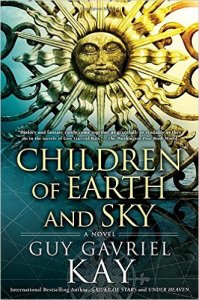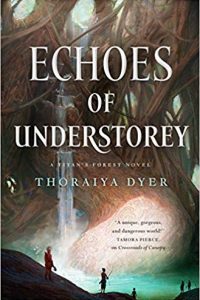Gary K. Wolfe reviews Guy Gavriel Kay
Children of Earth and Sky, Guy Gavriel Kay (NAL 978-0-451-47296-0, $27.00, 448pp, hc) May 2016. Cover by Larry Rostant
 In the brief acknowledgments at the end of his magnificent new novel Children of Earth and Sky, Guy Gavriel Kay mentions that his fictional Renaissance city of Obravic is an ‘‘amalgam,’’ and it occurs to me that this is as good a word as any for Kay’s much-discussed technique of combining history and fantasy, of renaming and essentially rebranding actual events, places, and characters for his own purposes. I suspect that by now he’s weary of being asked why he undertakes such meticulous background research (in this case, largely involving the Ottoman-Habsburg wars and the Siege of Vienna), when he isn’t particularly constrained by that research in the fiction, but in fact he is as constrained as he wants to be – only the constraints are perhaps more harmonic than melodic. He allows himself freedom to improvise up to a point, and that point is what defines his uniquely nuanced approach to his dialogue between fantasy and history. Instead of finding cavities in the historical record in which to insert fantasy spectacles (as Tim Powers did in that earlier entertaining fantasy built around the Siege of Vienna, The Drawing of the Dark), Kay wants to explore and enhance the fantasy-like resonance inherent in much historical fiction, and it’s a fair bet than many, if not most of his readers will have only the vaguest awareness of the historical Suleiman the Magnificent or the layout of Dubrovnik. His use of supernatural elements is deliberately, even tactically, restrained, and while a ghost is involved in one of the key events in Children of Earth and Sky, for the most part his ghosts serve, as they did in Shakespeare, as conduits of otherwise unavailable information (ghosts were essentially the mobile phones of Renaissance drama).
In the brief acknowledgments at the end of his magnificent new novel Children of Earth and Sky, Guy Gavriel Kay mentions that his fictional Renaissance city of Obravic is an ‘‘amalgam,’’ and it occurs to me that this is as good a word as any for Kay’s much-discussed technique of combining history and fantasy, of renaming and essentially rebranding actual events, places, and characters for his own purposes. I suspect that by now he’s weary of being asked why he undertakes such meticulous background research (in this case, largely involving the Ottoman-Habsburg wars and the Siege of Vienna), when he isn’t particularly constrained by that research in the fiction, but in fact he is as constrained as he wants to be – only the constraints are perhaps more harmonic than melodic. He allows himself freedom to improvise up to a point, and that point is what defines his uniquely nuanced approach to his dialogue between fantasy and history. Instead of finding cavities in the historical record in which to insert fantasy spectacles (as Tim Powers did in that earlier entertaining fantasy built around the Siege of Vienna, The Drawing of the Dark), Kay wants to explore and enhance the fantasy-like resonance inherent in much historical fiction, and it’s a fair bet than many, if not most of his readers will have only the vaguest awareness of the historical Suleiman the Magnificent or the layout of Dubrovnik. His use of supernatural elements is deliberately, even tactically, restrained, and while a ghost is involved in one of the key events in Children of Earth and Sky, for the most part his ghosts serve, as they did in Shakespeare, as conduits of otherwise unavailable information (ghosts were essentially the mobile phones of Renaissance drama).
Children of Earth and Sky returns us to the Europe of Kay’s Sarantine Mosaic, beginning some 25 years after the fall of Sarantium, Kay’s version of Byzantium. As with all of Kay’s best work, however, its power derives less from its tweaking of history than from its complex, nuanced characters whose stories come to intertwine in revealing ways; it’s no accident that Kay chooses metaphors like tapestries and mosaics for his novels and series. Among the most appealing are Danica Gradek, a skilled archer who has been drafted to join the swift-boat pirates of Senjan (a name only slightly altered from the Croatian town of Senj); Pero Villani, a young artist chosen for the risky assignment of painting a western-style portrait of the powerful khalif Gurçu, the Suleiman-like nemesis of eastern Europe; Leonora Valeri, rescued from her father’s cruelly imposed exile to serve as a spy for Seressa (a version of Venice); and Damaz, a young warrior kidnapped as a child and now rising through the ranks of the khalif’s elite infantry force the djanni (a pretty obvious variation on janissaries). As usual, there is a rich cast of secondary figures, from servants to ship captains, merchants, priestesses, and emperors (including the exiled empress of the fallen Sarantium). Kay has a remarkable gift for lending surprising depth to even walk-on figures, but the young people carry the burden of the narrative, and this lends the tale a particular poignance when the chronology opens up a bit toward the end of the novel.
In addition to his well-known skill at devising various diplomatic and court intrigues, Kay is hardly averse to kinetic action sequences and detailed battlefield strategies. For me, the novel really develops its momentum during an early pirate raid in which Leonora and Danica first meet and later develop a kind of survival friendship that reflects the problematic options available to women in Renaissance Europe. We first meet Damaz in a kind of set piece in which he challenges and defeats a rival trainee who is planning what amounts to a brutal hate crime, and later follow him as a foot-soldier during the khalif’s ill-fated siege. The artist Pero – who was also aboard that ship that Danica helps raid, and who fell in love at first sight with Leonora – gets his own turn later on when he finds himself in a kind of psychological cat-and-mouse game with the terrifying khalif Gurçu, who could of course have him killed at any moment, and the khalif’s scheming family. As these various threads merge in ingenious ways – always just a bit short of seeming too ingenious – Kay builds a convincingly human answer to the paradox that has long made the Renaissance so hypnotic, so alien, and familiar with its juxtaposition of crude brutality and magnificent beauty, of high manners and low betrayals, of emerging technology and stark primitivism. It’s an amalgam, all right, but it’s also a tapestry of the sort that no one but Kay really seems to know how to do.






